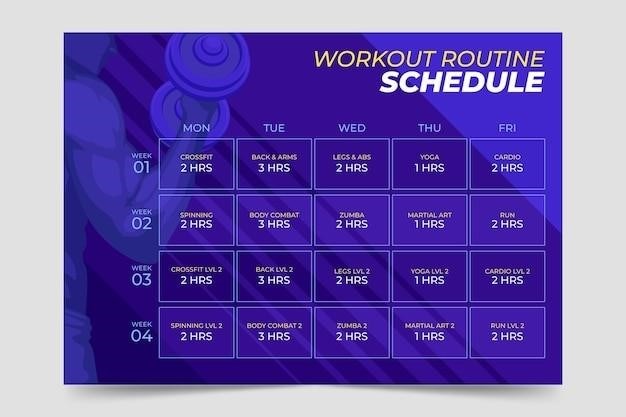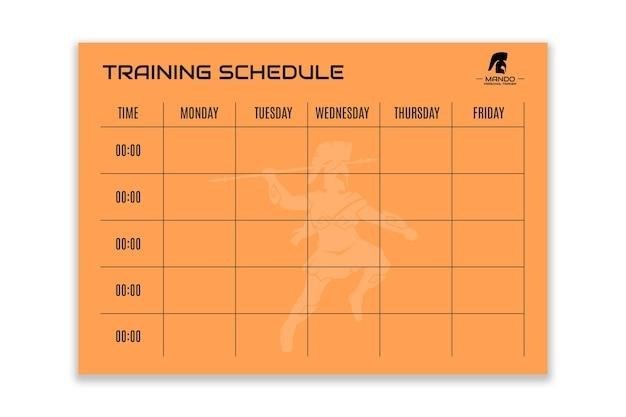800m Training Schedule PDFs⁚ A Comprehensive Overview
This overview explores readily available 800m training schedule PDFs‚ detailing various program types‚ sample workout weeks‚ and crucial elements for effective training‚ including aerobic development‚ anaerobic capacity‚ and speed/strength. It also addresses goal setting‚ weekly structure‚ recovery‚ and individual needs.
Finding Suitable Training Plans
Locating the right 800m training schedule PDF requires careful consideration of several factors. Begin by assessing your current fitness level and racing experience. Beginner plans differ significantly from those designed for seasoned athletes aiming for elite performance. Consider your training history‚ identifying strengths and weaknesses to choose a program that aligns with your needs. Online resources‚ coaching websites‚ and athletic publications offer various plans‚ often categorized by experience level and specific goals (e.g.‚ improving time‚ building endurance). Carefully review the plan’s structure‚ including the types of workouts (intervals‚ tempo runs‚ long runs)‚ their frequency‚ and the overall training volume. Reading reviews and testimonials from other runners can provide valuable insights into a plan’s effectiveness and suitability. Remember to select a plan that fits your lifestyle and allows for sufficient rest and recovery. Don’t hesitate to modify a plan based on your individual response to training. A well-structured plan should gradually increase intensity and volume to avoid injury and burnout.
Types of 800m Training Programs
800m training programs vary considerably depending on the runner’s goals and experience. Some focus intensely on speed development‚ incorporating high-intensity intervals and sprint work to improve acceleration and top-end speed. Others prioritize endurance building‚ using longer‚ sustained runs and tempo workouts to enhance aerobic capacity. A balanced approach combines both speed and endurance training‚ with a periodization structure that alternates between these focuses throughout the training year. Some plans emphasize strength training‚ incorporating weightlifting or plyometrics to enhance power and reduce injury risk. Furthermore‚ plans may incorporate specific drills to improve running form and efficiency. The choice of program depends on the individual runner’s needs and the coach’s philosophy. Many programs are structured around a four-week cycle‚ each week dedicated to speed‚ strength‚ recovery‚ or race simulation. It’s essential to choose a program aligned with your experience‚ goals‚ and available training time.
Sample 800m Workout Weeks
Numerous 800m training schedule PDFs offer sample workout weeks. A typical mid-season week might include⁚ Monday – 800m tempo run; Tuesday – interval training (e.g.‚ 400m repeats); Wednesday – easy run; Thursday – strength training or plyometrics; Friday – speed work (e.g.‚ 200m repeats); Saturday – long run; Sunday – rest or cross-training; Variations exist depending on the training phase. Early-season weeks emphasize base building with longer‚ slower runs‚ while later-season weeks focus on race-specific workouts and speed development. Some plans include specific warm-up and cool-down routines. Remember that these are examples‚ and individual needs may necessitate adjustments. Consider the provided examples as templates; they should be adapted to personal fitness levels‚ race goals‚ and recovery needs. Always prioritize proper warm-up and cool-down exercises to prevent injuries. Consult a coach for personalized guidance.
Key Elements of an Effective 800m Training Schedule
Effective 800m training plans integrate aerobic base building‚ anaerobic capacity workouts‚ and speed/strength training. A well-structured schedule also prioritizes adequate rest and recovery for optimal performance and injury prevention.
Aerobic Development
Aerobic development forms the foundation of any successful 800m training program. It involves building a strong cardiovascular base‚ enabling athletes to sustain effort over the race distance. This is achieved through consistent long‚ slow distance runs‚ often incorporating easy jogging or tempo runs at a conversational pace. The duration and intensity of these runs gradually increase over time‚ enhancing endurance and lactate threshold. Resources like “Highly Intelligent Training” by Livingstone‚ “No Bugles‚ No Drums” by Snell‚ and “Running to the Top” by Lydiard offer valuable insights into Olympic-level aerobic development‚ emphasizing the importance of a well-structured approach. These plans typically incorporate a variety of aerobic exercises‚ including steady-state runs‚ fartleks (speed play)‚ and tempo runs‚ each designed to improve different aspects of aerobic fitness. Proper pacing and recovery are crucial to avoid overtraining and maximize the benefits of aerobic training‚ ensuring a strong foundation for the more intense training phases.
Anaerobic Capacity Workouts
Anaerobic capacity training is crucial for 800m success‚ focusing on the body’s ability to produce energy without oxygen. High-intensity interval training (HIIT) is a cornerstone‚ involving short bursts of intense effort followed by brief recovery periods. Examples include 600m time trials (multiplying the time by 1.4 to predict 800m performance)‚ 400m repeats‚ and 200m sprints. These workouts target the anaerobic glycolytic system‚ responsible for energy production during the latter stages of an 800m race. The number of repetitions‚ distance‚ and rest intervals are adjusted based on the athlete’s fitness level and training phase. Proper warm-up and cool-down are essential to prevent injury. While sample 800m anaerobic workouts are available online‚ personalized plans are recommended‚ adapting the intensity and volume to the individual’s capabilities and race goals. Monitoring progress and adjusting the training plan accordingly ensures optimal results and reduces the risk of overtraining.
Speed and Strength Training
Incorporating speed and strength training into your 800m program is vital for optimal performance. Speed work focuses on improving stride frequency and length‚ crucial for maintaining pace during the race. This includes drills like short sprints‚ acceleration runs‚ and plyometrics. Strength training builds lower body power and endurance‚ contributing to improved running economy and injury prevention. Exercises should target major muscle groups‚ including quads‚ hamstrings‚ glutes‚ and core. Weight training‚ bodyweight exercises‚ and resistance band work are all effective methods. The intensity and volume of both speed and strength training should be carefully planned and progressively increased to avoid overtraining and injury. Consider incorporating hill training to improve leg strength and power‚ while plyometrics enhances explosiveness. Remember that proper form is crucial to maximize benefits and minimize risk of injury. A balanced approach‚ integrating speed and strength training with other components of your plan‚ is key to holistic 800m performance enhancement.

Planning Your 800m Training Program
Effective 800m training requires careful planning‚ encompassing realistic goal setting‚ a structured weekly schedule‚ and a dedicated rest and recovery plan to prevent overtraining and maximize performance gains. Prioritize these elements.
Setting Realistic Goals
Establishing achievable goals is paramount for a successful 800m training program. Begin by honestly assessing your current fitness level and race times. Are you a beginner‚ intermediate‚ or advanced runner? What are your personal best times in the 800m and related distances (e.g.‚ 400m‚ 1500m)? Based on this self-assessment‚ set SMART goals⁚ Specific‚ Measurable‚ Achievable‚ Relevant‚ and Time-bound. Instead of aiming for a drastic improvement‚ focus on incremental progress. For instance‚ you might aim to improve your 800m time by 5 seconds within a specific timeframe (e.g.‚ 8 weeks). Consider setting both short-term and long-term goals to maintain motivation and track your progress effectively. Remember to consult with a coach or experienced runner for personalized guidance in setting realistic and challenging goals tailored to your individual circumstances and capabilities. Regularly review and adjust your goals as you progress and gain experience.
Weekly Schedule Structure
A well-structured weekly training schedule is crucial for optimal 800m performance. A typical week might incorporate several types of workouts⁚ long runs for aerobic base building‚ interval training for speed and endurance‚ tempo runs to improve lactate threshold‚ and strength training to enhance power and prevent injuries. Rest and recovery days are equally important for muscle repair and injury prevention; these should be strategically placed throughout the week. The intensity and volume of workouts should vary throughout the week‚ following a periodization model. For example‚ higher intensity workouts (intervals‚ tempo) might be scheduled mid-week‚ while longer‚ easier runs are done on other days. Consider incorporating cross-training activities‚ such as swimming or cycling‚ for active recovery and to prevent overuse injuries. The specific structure of your weekly schedule will depend on your individual training level‚ race goals‚ and overall training plan. Remember to prioritize proper warm-up and cool-down routines before and after each workout session to maximize benefits and minimize risk of injury;
Incorporating Rest and Recovery
Adequate rest and recovery are paramount in an 800m training program. Overtraining leads to injury‚ burnout‚ and plateaued performance. Rest days allow the body to repair and rebuild muscle tissue damaged during intense workouts. Active recovery‚ such as light jogging or swimming‚ aids in blood flow and reduces muscle soreness. Sleep is crucial; aim for 7-9 hours of quality sleep per night. Nutrition plays a vital role; ensure sufficient caloric intake to support training demands and prioritize nutrient-rich foods for muscle repair. Listen to your body; don’t ignore signs of fatigue or pain. Overtraining can manifest as decreased performance‚ persistent muscle soreness‚ and increased susceptibility to illness. Incorporate rest weeks or deloading periods into your training schedule to prevent overtraining. These periods involve reduced training volume and intensity‚ allowing for complete physical and mental recovery. Proper hydration is also essential; drink plenty of water throughout the day‚ especially during and after workouts.

Additional Resources and Considerations
This section covers supplementary reading‚ safety precautions crucial for injury prevention‚ and personalized plan adjustments based on individual needs and training levels. Explore further resources to enhance your training knowledge.
Recommended Reading Material
Several books offer valuable insights into 800m training methodologies. “Highly Intelligent Training” by Livingstone provides a comprehensive approach to aerobic development‚ crucial for endurance in the 800m. Similarly‚ “No Bugles‚ No Drums” by Snell offers another perspective on training philosophies‚ emphasizing the importance of strategic planning and periodization. For a more holistic understanding of training at an elite level‚ consider “Running to the Top” by Lydiard‚ which explores the connection between training intensity‚ volume‚ and recovery. These texts provide a range of perspectives that can be invaluable for runners seeking to optimize their 800m training programs. Supplementing these books with online resources and coaching advice can further enhance training effectiveness and lead to better performance outcomes. Remember that a well-rounded approach‚ incorporating elements from various sources‚ often yields the best results.
Potential Risks and Safety Precautions
Intense 800m training carries inherent risks. Muscle soreness‚ exhaustion‚ and dehydration are common‚ necessitating proper hydration and rest. More serious risks include injuries like muscle strains‚ ligament tears‚ tendonitis‚ or even bone fractures. Fainting‚ falls‚ and seizures are possibilities‚ especially with inadequate preparation or overtraining. Cardiovascular issues‚ such as heart attacks‚ represent a severe‚ though less frequent‚ risk. Therefore‚ a thorough medical checkup before starting any strenuous training program is vital. Consult a physician or physical therapist for guidance on injury prevention and management. Listen to your body; don’t push through pain. Gradual progression of training intensity is crucial to minimize risks. Proper warm-up and cool-down routines are also essential components of a safe and effective training plan. Prioritize safety to avoid injury and ensure long-term success.
Adapting Plans to Individual Needs
Generic 800m training schedules serve as valuable starting points‚ but individualization is key for optimal results. Consider current fitness levels; beginners should start with less intense programs‚ gradually increasing volume and intensity. Training age plays a significant role; younger athletes might require more emphasis on foundational strength and conditioning. Pre-existing conditions‚ injuries‚ or limitations necessitate modifications. A coach’s guidance can be invaluable in tailoring a plan; Personal preferences also matter; some thrive on structured routines‚ while others prefer more flexibility. Regular monitoring of progress is vital; adjust the plan based on performance and feedback from your body. Don’t hesitate to seek professional help. Remember that recovery and rest are crucial elements‚ and their needs vary among individuals. Prioritize sustainable training to avoid burnout and injury. Adapt the plan to your unique needs for success.


